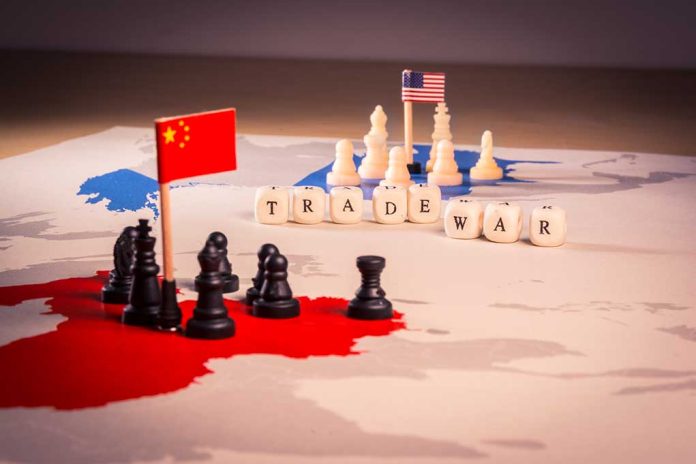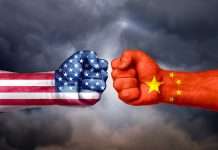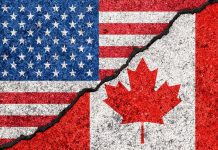
President Trump’s economic war with China just wiped out $19 trillion in global market value as both countries escalate tariffs to unprecedented levels, threatening a worldwide recession and devastating key American industries.
At a Glance
- President Trump has imposed tariffs exceeding 120% on Chinese goods, while Beijing retaliated with 84% tariffs on US products
- The escalating trade war has contributed to approximately $19 trillion in losses across global equity markets since February
- Key US industries at risk include agriculture, aviation, automotive, and technology sectors
- Economists are increasingly predicting a US recession due to the ongoing economic conflict
- Former Treasury Secretary Janet Yellen warned that economic decoupling would be “disastrous for both” nations
America’s Economic Showdown with China
President Trump’s aggressive stance against China’s unfair trade practices has escalated into a full-scale economic confrontation, with both nations now engaged in the largest tariff battle in modern history. The President imposed duties exceeding 120% on Chinese imports after Beijing failed to address long-standing trade imbalances that have disadvantaged American workers for decades. China swiftly retaliated with crushing 84% tariffs on US goods, signaling their unwillingness to back down despite mounting economic pressure. This high-stakes standoff represents the President’s determination to correct the $361 billion trade deficit the US suffered against China in 2024 alone.
The immediate economic fallout has been severe, with approximately $19 trillion wiped from global equity markets since mid-February. US Treasury yields have experienced their worst selloff since the pandemic, and major stock indices have plummeted as investors flee to safety. While the President’s tariffs are designed to protect American manufacturing and bring jobs back to the homeland, the short-term market volatility has rattled even the most steadfast economic observers who worry about potential supply chain disruptions and inflation risks as the economic battle unfolds.
Critical American Industries Under Threat
The agricultural sector stands as one of the most vulnerable American industries in this economic confrontation. US farmers, particularly soybean producers who rely heavily on Chinese markets, face potentially devastating losses if retaliatory tariffs restrict their access to Chinese buyers. The automotive industry isn’t faring much better, with companies like Ford and General Motors already preparing for production pauses and possible workforce reductions as supply chains fragment and component costs rise. These manufacturing disruptions could ripple through American communities that depend on these industries for stable employment.
“Our two economies are deeply integrated, and a wholesale separation would be disastrous for both,” warned former Treasury Secretary Janet Yellen before the latest escalation, highlighting the interconnected nature of the world’s two largest economies.
The aviation sector faces perhaps the most immediate threat, with Boeing particularly vulnerable due to existing delivery agreements with Chinese airlines. Any disruption to these contracts could force additional layoffs in an already struggling American aerospace industry. Similarly, US technology giants that rely on semiconductor supply chains stretching between the two countries are scrambling to develop contingency plans as both nations weaponize trade policies in this economic chess match. The domestic impact could be substantial as these industries employ millions of Americans whose livelihoods now hang in the balance.
China’s Economic Resilience Versus America’s Resolve
While China appears better positioned to weather the immediate economic storm through state-controlled market interventions and domestic stimulus measures, their economy faces serious underlying challenges that complicate their response. Already grappling with deflation, a property market crisis, and high debt levels, Beijing now faces additional pressure from tariffs that could reduce their GDP growth to as low as 4% according to UBS analysts. The Chinese government has deployed emergency measures to stabilize their stock market and mitigate economic shocks, but their export-dependent economic model remains fundamentally vulnerable to American trade restrictions.
“We Chinese are not troublemakers, but we will not flinch when trouble comes our way,” stated Lin Jian, China’s foreign ministry spokesperson, reflecting the combative stance Beijing has adopted in response to President Trump’s economic pressure campaign.
President Trump remains steadfast in his commitment to rebalance the trading relationship despite market turbulence. “China also wants to make a deal, badly, but they don’t know how to get it started. We are waiting for their call. It will happen!” the President declared with characteristic confidence. This economic confrontation represents a crucial test of American resolve against China’s unfair practices that have hollowed out American manufacturing for decades. While painful in the short term, many supporters view these measures as necessary medicine to restore American economic sovereignty and industrial capacity after years of decline.






















